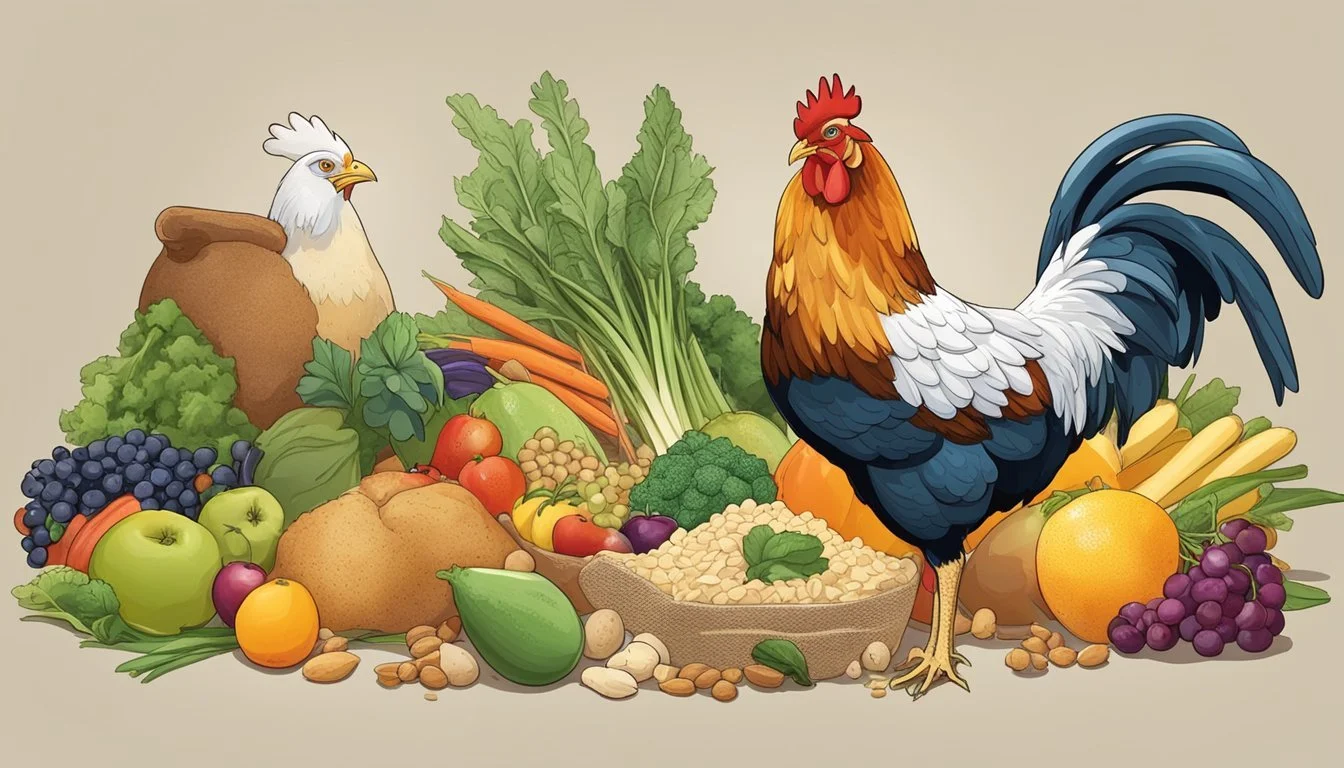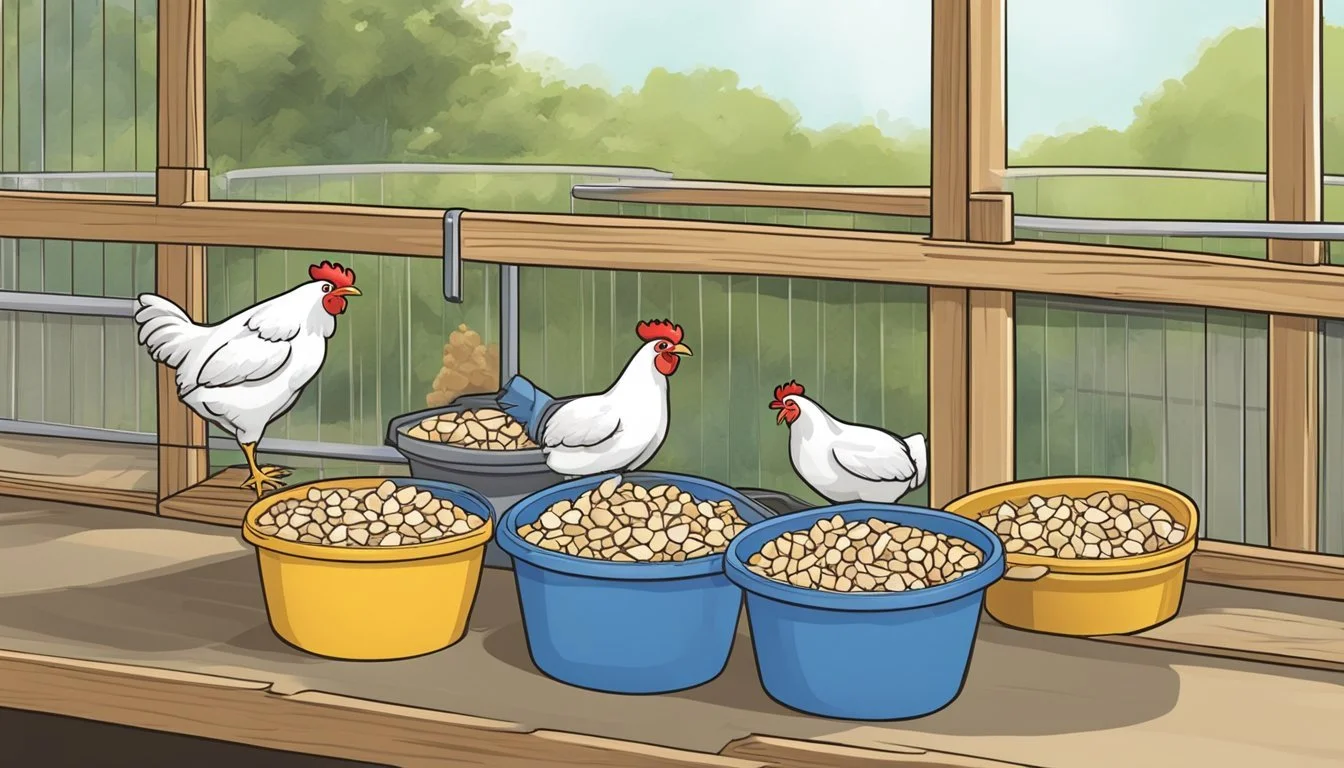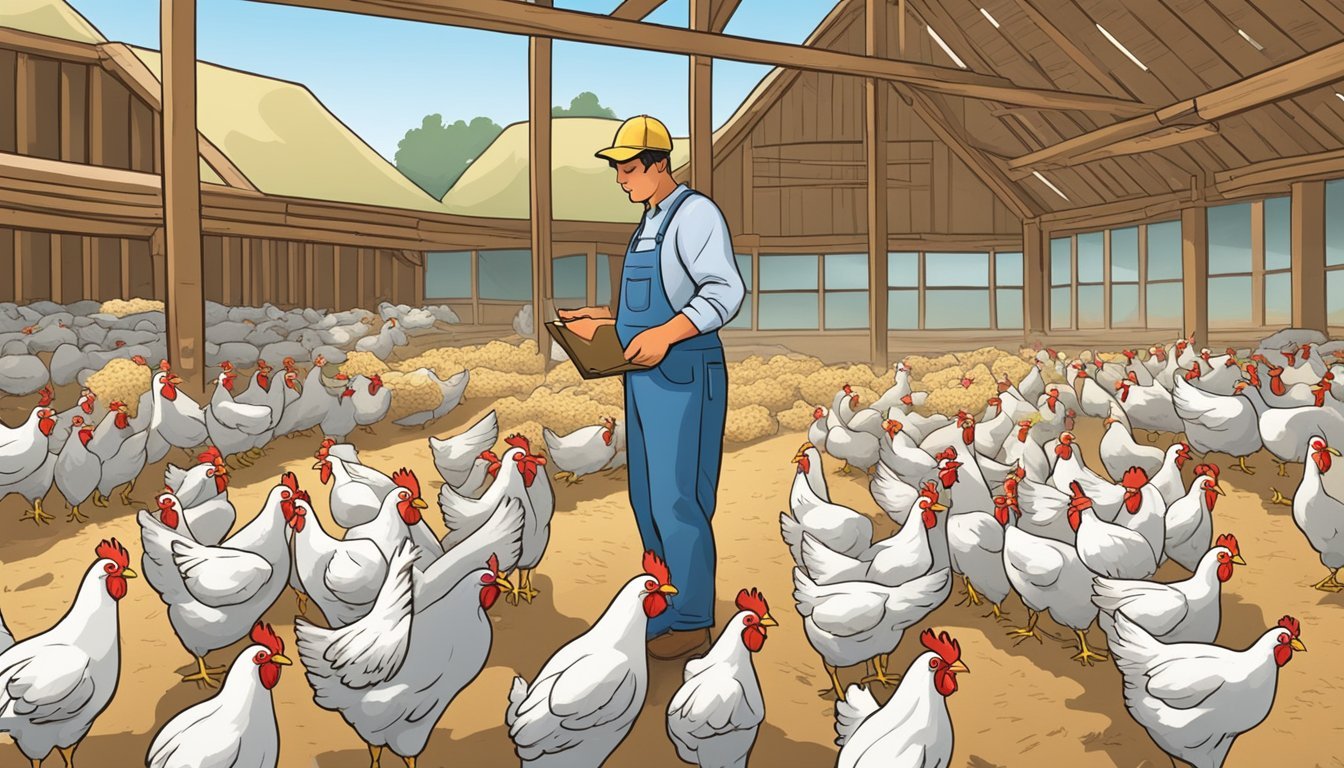How do I Manage a Chicken's Diet
Nutritional Needs for Laying vs. Non-Laying Hens
Managing a chicken's diet is crucial for their health and egg production. When chickens are laying, their nutritional needs differ significantly compared to periods when they are not. A laying hen requires a well-balanced diet rich in protein, vitamins, and minerals to maintain consistent egg production. Protein supports the development of eggs, while calcium and phosphorus are essential for forming strong eggshells. Adjusting the diet according to a chicken's laying status ensures their energy needs are met without overfeeding, which can lead to obesity and a decline in laying performance.
In contrast, during non-laying periods, typically when hens molt or during the shorter days of winter, their dietary needs change. The focus shifts from high energy and protein requirements to maintaining a healthy weight and overall condition. While the protein levels in their feed may be lowered, it remains important to provide a balanced diet to support their well-being. Maintaining a proper nutritional balance is key to a chicken's health and readiness to resume laying.
Tailoring the diet to the chickens' laying cycle and watching for signs of nutritional deficiencies can prevent issues and ensure a flock's productivity. The protein amounts for grower feed is usually around 14-18% by weight and is appropriate until chickens reach 20-22 weeks of age or when they commence laying. For laying hens, a diet that satisfies their increased nutritional demands, with a particular emphasis on calcium for eggshell quality, is obligatory. Careful management of lighting conditions could also enhance the laying cycle and optimize feed conversion.
Understanding Chicken Nutrition
In managing chicken diets, one must consider the varying nutritional requirements during their laying and non-laying phases. Specific nutrients, such as protein and calcium, are critical for their health and productivity.
Nutritional Needs of Laying Hens
Laying hens require a diet high in calcium and protein to ensure the production of strong eggshells and the maintenance of their own bone density. Calcium is critical; laying hens generally need about 3.5-4.0 grams of calcium per day, which can be found in layer feed typically containing 3.0% to 3.5% of this mineral. An adequate supply of protein, around 16-18%, is essential not only for egg production but also to support bodily functions and feather health. Additionally, laying hens benefit from a range of amino acids, like methionine and lysine, to synthesize proteins efficiently.
Importance of Balanced Diet for Non-Laying Hens
For non-laying hens, a balanced diet still plays a vital role in their overall health. Their feed should contain a moderate level of protein, ideally around 14-16%, to support their maintenance needs without the excess required for egg production. It is less about the quantity and more about the quality of nutrients they consume. A diet balanced in vitamins, minerals, and amino acids helps sustain the immune system and vital body functions. It is necessary to adjust the food to their less intense nutritional demands, which helps prevent obesity and other health issues.
In both cases, it is vital to provide chickens with a mix of grains, greens, proteins, and adequate water to ensure they are receiving complete nutrition.
The Role of Diet in Egg Production
The dietary needs of chickens considerably influence their ability to lay eggs efficiently. Providing optimal nutrition through layer feed and supplements is crucial for both egg quantity and quality.
Optimizing Layer Feed
Layer feed is specially formulated to meet the nutritional demands of laying hens. A proper layer feed should be rich in protein, as it plays a pivotal role in egg production. Typically, a laying hen's diet requires approximately 16-18% protein content. In addition, calcium is indispensable for forming strong eggshells. Layer feed should contain about 3-4% calcium. These specific dietary components ensure that the hen can produce eggs consistently while maintaining her own health.
Supplements for Enhanced Egg Quality
While a well-balanced layer feed is the cornerstone of a hen's diet, adding supplements can further enhance egg quality. Ingredients like fish oil or flaxseed can increase the omega-3 fatty acid content of the eggs. Vitamin D3 supplements are also beneficial as they aid in calcium absorption, making the eggshells harder and more resilient. Offering crushed oyster shells as a supplement can help provide additional calcium, which is especially helpful if dietary intake is insufficient.
Factors Affecting Chicken Diet
Managing a chicken's diet requires consideration of various factors, such as their life stage and the changing environment, to ensure their nutritional needs are met for optimal health and egg production.
Age and Dietary Changes
When chickens transition from growers to layers, their diet must change to accommodate different nutritional requirements. Young chickens typically consume grower feed, which contains about 14-18% protein, until they are 20-22 weeks of age when they are ready to lay eggs. At this point, they should switch to layer feed to support egg production, which will require higher levels of calcium for strong eggshells.
Adapting to Seasonal Variations
Chickens' dietary needs can change with the seasons. During winter, they will need more energy to keep warm, so an increase in calorie-dense foods may be necessary. Additionally, they may consume less feed overall due to reduced daylight hours, making it crucial to ensure that what they do eat is nutrient-rich to maintain their health and production levels.
Stress and Its Impact on Feeding
Stressful conditions can significantly alter a chicken's feed intake and nutritional needs. Factors causing stress might include extreme weather, threats from predators, or changes in their environment. During these times, it is important to provide a diet that supports their immune system and maintains healthy body weight.
Illness and Recovery Diet
If a chicken falls ill, their dietary requirements will shift. They may need easily digestible foods, possibly in a wet mash form, and additional vitamins and nutrients to support recovery. The recovery diet should focus on rebuilding strength without overburdening their system.
Feeding Practices for Health and Productivity
A well-managed diet is pivotal for the health and productivity of laying chickens, focusing on adequate nutrition, water quality, and controlled supplementation. Vigilant management guards against parasites and pests that can affect the flock's health.
Proper Feeding Techniques
Laying hens require a diet rich in calcium and protein to support egg production. Feeding a layer feed with about 16-18% protein and higher calcium levels is essential. They benefit from consistent feeding times each day. During molting, which typically occurs once a year, hens may need a higher protein feed to support new feather growth.
Water Availability and Quality
Clean, fresh water must be available at all times as it profoundly affects a chicken's overall health and egg production. Plenty of water intake is crucial, so waterers should be cleaned regularly to prevent the spread of disease and deter predators who might be attracted by dirty water sources.
Managing Treats and Extras
While treats can be offered and are enjoyed by chickens, they should never exceed 10% of a chicken's diet. Healthy options include fruits, vegetables, and grains. Excessive treats can unbalance a diet and detract from the nutritional intake of their main feed.
Monitoring for Parasites and Pests
Regular checks for parasites such as lice and mites are critical, as they can impact a chicken's well-being and its productivity. Using deterrents and maintaining clean living conditions are proactive steps to reduce issues. Management practices should include periodic treatments and habitat modifications to minimize pest presence.
Diet Transition Strategies
Managing a chicken's diet effectively is crucial for their health and productivity, especially when transitioning from non-laying periods to laying phases or during molting periods.
Shifting From Grower to Layer Feed
When chickens transition from adolescence to laying adulthood, their nutritional needs change significantly. Grower feed, typically given until about 18 weeks of age, is lower in calcium than layer feed, which is necessary for eggshell formation. To shift chickens from grower to layer feed:
Week 1: Begin by mixing 25% layer feed with 75% grower feed.
Week 2: Adjust the mix to 50% layer feed and 50% grower feed.
Week 3: Increase to 75% layer feed and 25% grower feed.
At the end of this three-week process, chickens should be fully transitioned to layer feed. Laying chickens require this higher-calcium diet to maintain their egg-laying productivity without depleting their own body's calcium reserves.
Coping with Molting Periods
Molting is a natural process where chickens shed old feathers and regrow new ones, often leading to a temporary pause in egg production. During molting, chickens will benefit from a diet that supports feather regrowth, which is high in protein.
During molting, consider increasing the protein content of their feed or supplementing with high-protein snacks. Layer feed may be lower in protein compared to grower feed, so look for a molting-specific formula or reintroduce grower feed temporarily if it has a higher protein content.
Cutting back slightly on calories can help broody hens return to laying, as it can encourage them to leave the nest and seek out food. However, this must be done with care to avoid undernourishment. Once feathers begin to regrow and chickens show signs of leaving broodiness, slowly reintroduce the regular layer ration to help them return to their usual laying routine.
Environmental Considerations
When managing a chicken's diet during lay periods, environmental factors such as light exposure, weather conditions, and coop setup play a vital role. They influence not just the intake but also the effectiveness of the diet provided.
Artificial Lighting in Coops
Chickens need adequate artificial light to maintain egg production, especially during the shorter days of the year. It's recommended to gradually increase the day length to a period of 14-16 hours of light per day at peak production to simulate longer daylight hours, thereby optimizing their laying cycle. Proper lighting ensures that chickens eat enough to meet their nutritional needs when natural light is insufficient.
Maintaining Diet During Extreme Weather
During extreme weather conditions—be it intense heat or cold—chickens' dietary needs can change. Insulating the coop is crucial in maintaining a more stable internal temperature. Adequate insulation helps reduce stress caused by the weather, ensuring chickens have a consistent appetite. Owners should also ensure that feed and water supply remains unfrozen and accessible. In hot weather, providing electrolytes and easy access to cool, fresh water can keep chickens hydrated and prevent heat stress.
Coop Setup and Accessibility to Feeders
The layout of the coop directly affects how chickens interact with their food and water sources. Feeders and waterers should be placed in locations that are easily accessible but also protected from the elements. This allows chickens to eat and drink as needed, irrespective of the weather. Ensuring that chicken feeders and chicken waterers are clean and filled regularly promotes healthy eating habits and helps in the prevention of diseases.
Lifecycle Feeding
Managing a chicken's diet requires careful consideration of the bird's life stage and purpose. From egg-laying to retirement, each phase necessitates specific nutritional adjustments to maintain health and productivity.
Diet Adjustments for Older Hens
When hens reach old age, their dietary needs change. Typically, laying diminishes, and thus, their diet should shift to a lower protein level, around 14-16%, to prevent kidney damage and overweight issues. It is crucial to supplement with calcium-rich feed, because even decreased, egg production continues and can deplete calcium reserves, affecting bone strength. Offer a balanced diet that ensures they get enough vitamins and minerals to support their overall health.
Integrating New Chickens into the Flock
Integrating new chickens into an established flock requires a graduated feeding program that aligns with the existing birds. Start newcomers on a starter feed, gradually mixing in the flock's current feed over a period of 7-10 days to avoid digestive disruptions. This transitional feeding helps bolster the new chickens' immune systems and reduces stress, paving the way for a smoother integration.
Transitioning from Laying to Meat Production
For chickens transitioning from laying to meat production, their diet should be adjusted to support muscle development and overall mass gain. The protein content is increased slightly than that of layers, to about 18-20%, to facilitate growth; additionally, the energy content is often higher. This switch can be guided by using feeds specifically designed for meat chickens, ensuring they receive the necessary nutrients for healthy weight gain and meat quality.
Recognizing and Addressing Feeding Issues
Proper nutrition is paramount for egg production in chickens. Recognizing and addressing feed-related issues quickly ensures a healthy flock and consistent egg yield.
Common Reasons Chickens Stop Laying Eggs
Chickens may cease laying eggs due to various factors, with nutritional deficiencies being a primary concern. An improper diet that lacks essential nutrients like calcium or protein can disrupt egg production. Also, stress from environmental changes or lack of water intake can lead to a halt in laying. To combat these challenges, review the flock's diet regularly and ensure they have access to clean water at all times, adjusting the feed based on protein amounts as necessary.
Dealing with Decreased Appetite and Egg Production
A noticeable decrease in appetite and egg production often indicates health or environmental issues. First, verify that the chickens receive a balance of essential amino acids, vitamins, and minerals in their diet. If the diet adheres to nutritional standards yet issues persist, investigate for possible illnesses or stress factors within the coop. Adjust diets accordingly to compensate for the decreased intake and monitor for improvements.
Quarantine and Special Care Feeding
When a chicken exhibits signs of illness, it's prudent to quarantine the affected bird to prevent the spread of disease. During this time, offer specialized feed to address the specific needs of the convalescing bird. This may involve higher protein feeds or the addition of supplements to bolster their immune system. Observe quarantined chickens closely for changes in eating habits and adapt their diet to encourage recovery. Consider introducing probiotics or other digestive aids to support gut health, particularly if normal feed isn't being consumed adequately.
Practical Feeding Tips
Managing a chicken's diet is crucial for optimal health and egg production. Laying hens require sufficient proteins while non-layers benefit from a balanced diet to support their general well-being. Here are practical feeding tips to ensure your chickens are getting the right nutrients at the right times.
Homemade Feed Options
Creating a homemade feed can control nutritional intake for layers and non-layers alike. For layers, one might include a mix of grains such as corn and wheat fortified with 16-18% protein layer feed, ensuring they have the nutrients necessary for producing fresh eggs. Non-layers do not require the extra protein but need a well-rounded diet that could consist of a grower feed blend, supplemented by garden greens and grains.
Using Forage and Pasture
Chickens are natural foragers, and they thrive in environments where they can peck at pasture and forage. Not only does this activity support their instinctual behaviors, but it also supplements their diet with natural sources of vitamins and minerals. Laying hens benefit from the bugs and insects they consume, which provide extra protein, a practice beneficial for both their diet and the overall pest control of the area.
Insect and Bug Hunting
As omnivores, chickens enjoy a varied diet and are adept at catching bugs and insects, which are excellent sources of protein. Encourage this natural behavior by allowing your chickens to roam in a safe, contained outdoor area where they can hunt for these treats themselves. For those chickens, like broodies, that might not venture out as often, consider providing chicken treats such as mealworms or crickets to ensure they're still getting the extra protein they require.




